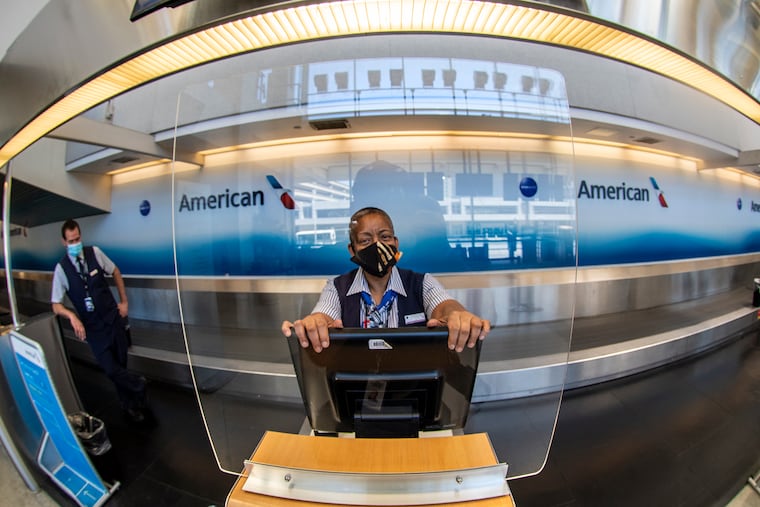How Philadelphia International Airport is adapting safety measures to the coronavirus
"We have to give people the power to control their own journey," the airport's chief revenue officer says.

If coming to the airport was a stressor before the pandemic, “put that on steroids and now you have a typical travel experience,” said James Tyrrell.
Tyrrell should know. As Philadelphia International Airport’s chief revenue officer, he has to figure out how the airport will respond to the safety needs and expectations of the traveling public amid the global pandemic.
That means the airport needs to “re-establish trust” with passengers, he said: “We have to create a situation to enable them to avoid crowds and limit interactions. And we have to give people the power to control their own journey.”
The coronavirus crisis brought air travel to a near standstill this spring, taking a toll on PHL’s finances. The airport has deferred payments it normally collects from airlines, concessionaires, rental car companies, and hotels through June. There is “zero revenue coming in,” Tyrrell said. PHL is, for now, using the $116 million in funding it received under the CARES Act to pay for operating expenses. It costs a little over $1 million a day to operate the airport, said Tyrrell.
Passenger traffic has built up slowly. Just ahead of Memorial Day weekend, 4,938 travelers went through airport security on Thursday, May 21, and 5,421 did so on Friday, May 22 — up from a low of about 1,200 daily travelers in mid-April. (By comparison, on those same two weekdays in May last year, 45,463 daily passengers and 46,613, respectively, passed through security.)
» READ MORE: City cleared out airport encampment of homeless people, offered tests for COVID-19
During this quieter period, airport leaders are "continuously discussing ways to address different requirements of this situation,” Tyrrell said.
For instance, airport policy now requires employees and passengers to wear face coverings. Decals on the floor in the ticketing area — and in other places where people line up — remind travelers to stand 6 feet apart. Airlines have also put up plexiglass shields at ticket counters.
Upstairs at the security area, maintaining physical distance has been easier so far, given the reduced flight schedule.
As passenger volumes pick up, though, implementing social distancing on a “normal” travel day will be a challenge, Tyrrell said: “We just don’t have the luxury of a ton of real estate." But airport officials are coordinating with TSA and the airlines, he said.
TSA recently announced its own set of changes at security checkpoints, which will roll out through mid-June. A spokesperson for the agency noted two updates in particular, regarding boarding passes and food items.
» READ MORE: As coronavirus cases mount, flight attendants grow increasingly fearful of flying
In the coming weeks, passengers should expect to start scanning their tickets on the boarding pass reader themselves, and then hold it up for a TSA officer to visually inspect.
Passengers traveling with food should put those items in a clear plastic bag, and place them in the bin, since food tends to trigger alarms during screening. “This requirement allows social distancing, reduces the TSA officer’s need to touch a person’s container of food, and reduces potential for cross contamination,” according to the agency.
As for those bins: TSA says it is “taking additional efforts” to clean them. But the agency is encouraging travelers to “follow CDC guidelines,” and wash their hands before and after going through the security checkpoint.
During screening, passengers should also keep wallets and keys inside their carry-on bags, and the same goes for lip balm, tissues, and cell phones. “This minimizes the placing of personal items in a bin that you might hold to your face,” TSA says.
Passengers can continue to go through security with one container of liquid hand sanitizer, up to 12 ounces, until further notice.
» READ MORE: ‘Every day, every flight’ is a coronavirus risk for flight attendants
Joe Shuker, president of the AFGE Local 333 union that represents TSA employees in Philadelphia, said that officers checking travel documents do have the protection of a face shield at the front of their podiums. But he hopes the podiums are outfitted with shields on the sides, as well, to prevent close contact.
The TSA spokesperson said the agency is exploring such a measure.
» HELP US REPORT: Are you a health care worker, medical provider, government worker, patient, frontline worker or other expert? We want to hear from you.
Once passengers get through security, they’ll find a limited number of concessions open for business. Most of the airport’s roughly 170 stores and restaurants remain closed. All the food options are grab-and-go, and tables in the food court have been spaced out.
Going forward, “the number of passengers will dictate how many stores we open," Tyrrell said. He expects the airport to continue to waive minimum guarantees, and to reduce rents for those businesses, “in hopes that they come out of this healthy.”
And there is still much to be determined. Will temperature checks become mandatory at airports, and if so, who would carry out, and pay for, that initiative? Will travelers keep using rideshares and taxis, or will more people drive themselves and park at the airport?
“There could be many paradigm shifts,” Tyrrell said.